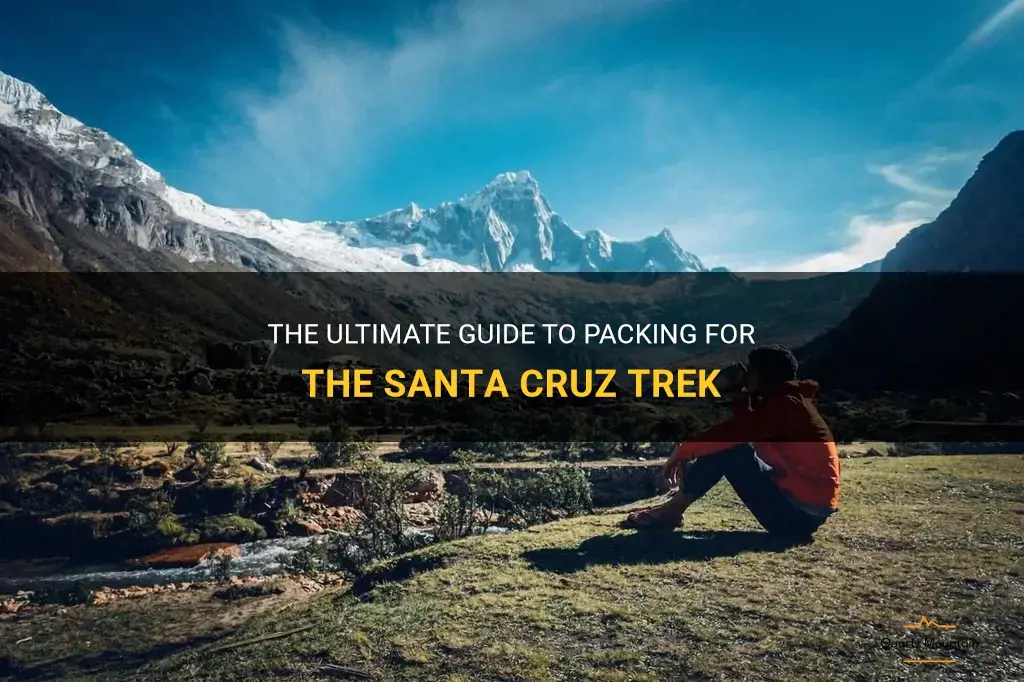
Are you planning a trekking adventure to the beautiful Santa Cruz trek in Peru? Unsure about what to pack for this exhilarating journey? Look no further! This ultimate guide will provide you with all the essential information and expert tips to ensure you pack everything you need for a successful and enjoyable trek. From clothing and camping gear to food and personal essentials, we've got you covered. Get ready to embark on an unforgettable adventure in the stunning landscapes of the Santa Cruz trek with confidence and peace of mind.
| Characteristics | Values |
|---|---|
| Duration | 4-5 days |
| Difficulty Level | Moderate to difficult |
| Fitness Level | Good fitness required |
| Altitude | 3,600m (11,811ft) to 4,750m (15,580ft) |
| Weather | Variable, with cold temperatures at higher altitudes |
| Clothing | Layered clothing for changing weather conditions |
| Footwear | Sturdy hiking boots |
| Backpack | 60-70 liter backpack |
| Sleeping Bag | 3-season sleeping bag |
| Tent | Lightweight tent suitable for 2 people |
| Cooking Equipment | Lightweight stove and cookware |
| Food | High-energy snacks, dehydrated meals |
| Water | Water purification tablets or filter |
| First Aid Kit | Basic first aid supplies |
| Trekking Poles | Recommended for stability and steep descents |
| Sun Protection | Sunscreen, hat, sunglasses |
| Insect Repellent | Mosquito repellent |
| Cash | Sufficient cash for any expenses along the trek |
| Maps/Guidebook | Detailed trail map or guidebook |
| Garbage Bags | To pack out trash |
| Camera | Optional, but recommended to capture the stunning views |
What You'll Learn
- What are the essential items to pack for the Santa Cruz trek?
- Are there any specific clothing items or gear that are recommended for the Santa Cruz trek?
- Should I bring my own camping equipment, or is it available for rent?
- What are some important items to include in a first aid kit for the Santa Cruz trek?
- Are there any special considerations for packing food and water for the trek?

What are the essential items to pack for the Santa Cruz trek?
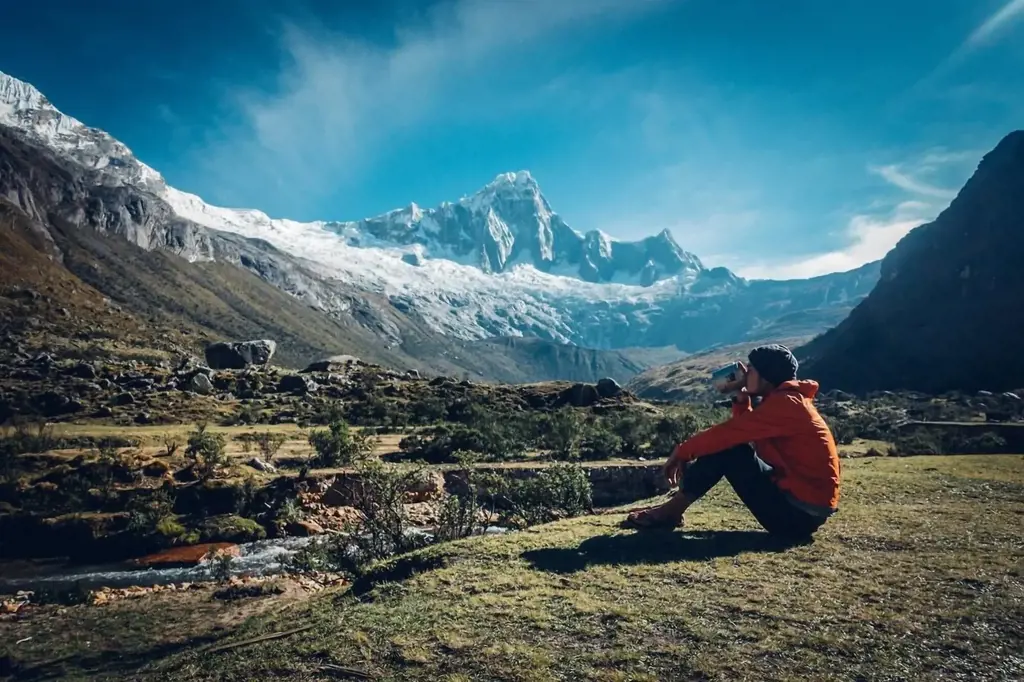
The Santa Cruz trek is a popular hiking route in the Cordillera Blanca mountain range in Peru. Spanning approximately 50 kilometers, this multi-day trek takes hikers through stunning landscapes, including snow-capped peaks, glacial lakes, and lush valleys. As with any hiking adventure, it is important to pack the right gear and essentials to ensure a safe and enjoyable experience.
Here are some of the essential items to pack for the Santa Cruz trek:
- Backpack: A comfortable and well-fitted backpack is crucial for carrying all your gear during the trek. Look for a backpack with a capacity of around 50-70 liters, which should provide enough space for your clothing, camping equipment, food, and water.
- Clothing: Dressing in layers is key for the ever-changing weather conditions in the Cordillera Blanca. Pack lightweight and breathable clothing for warmer days, including quick-drying t-shirts, hiking pants, and a hat to protect yourself from the sun. For colder weather, bring a warm fleece or down jacket, thermal base layers, gloves, and a beanie.
- Footwear: Invest in a sturdy pair of hiking boots that provide ankle support and have a good tread for the varied terrain. Make sure to break in your boots before embarking on the trek to avoid blisters and discomfort. Additionally, pack a pair of lightweight camp shoes or sandals for relaxing at the campsites.
- Sleeping bag and tent: The Santa Cruz trek involves camping in designated campsites along the route. It is essential to have a reliable sleeping bag and tent that can withstand the cold temperatures and potential rain. Look for a sleeping bag with a temperature rating suitable for cold weather camping, and a lightweight and easy-to-setup tent.
- Food and water: While there are opportunities to replenish your water supply along the trek, it is essential to bring a water filtration system or purification tablets to ensure safe drinking water. Pack lightweight and nutritious food, such as energy bars, nuts, dried fruits, and dehydrated meals that require minimal cooking.
- Navigation and safety gear: Carry a detailed map and compass or a GPS device to navigate the trail. It is also recommended to have a whistle, headlamp, first aid kit, sunscreen, insect repellent, and a multitool. It is important to be prepared for any potential emergencies or injuries that may occur during the trek.
- Other essentials: Don't forget to pack toiletries, including biodegradable soap, toilet paper, and a towel. Bring a lightweight and compact camping stove, cooking utensils, and a lightweight pot for cooking meals. It is also advisable to carry extra batteries and a power bank for charging your electronic devices.
When packing for the Santa Cruz trek, it is essential to consider the weight and functionality of each item. Aim to pack lightweight gear that serves multiple purposes and can withstand the rigors of the trek. It is also important to practice Leave No Trace principles and minimize your impact on the environment by packing out all waste and adhering to camping regulations. By packing the right essentials, you can fully enjoy the breathtaking beauty of the Santa Cruz trek while staying safe and comfortable throughout your journey.
The Ultimate Packing Guide for Exploring Salento
You may want to see also

Are there any specific clothing items or gear that are recommended for the Santa Cruz trek?
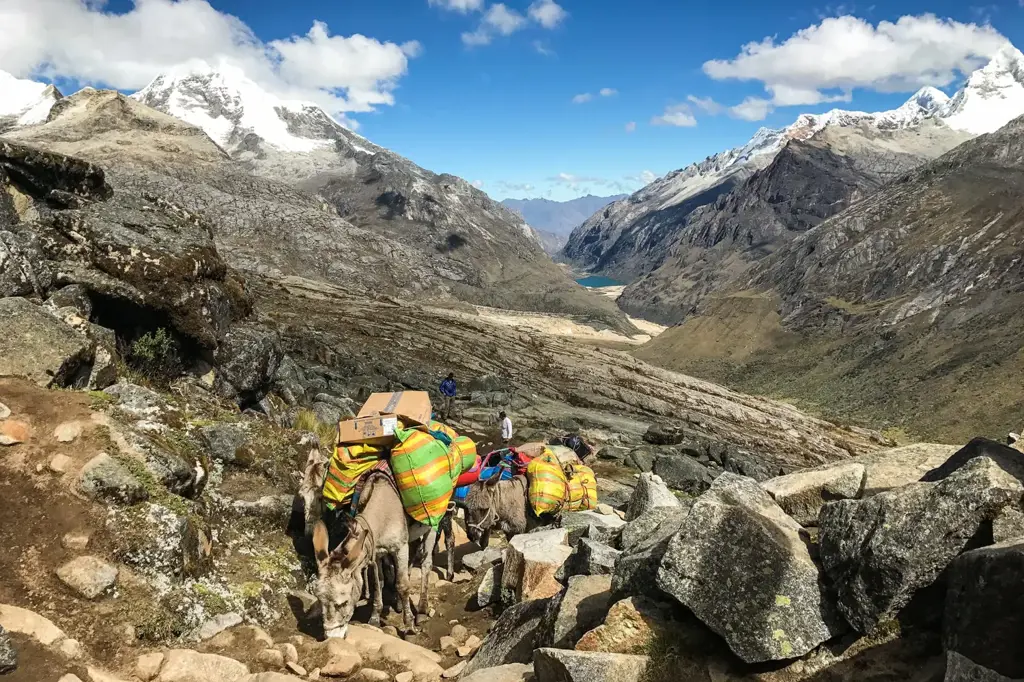
When embarking on the Santa Cruz trek in Peru, it is important to come prepared with appropriate clothing and gear to ensure a comfortable and safe journey. The Santa Cruz trek is a multi-day hike that takes you through stunning landscapes, high mountain passes, and unpredictable weather conditions. To make the most of this adventure, here are some recommended clothing items and gear to consider:
- Layered Clothing: It is crucial to have a layered clothing system to adapt to the changing weather conditions. Start with a moisture-wicking base layer to keep you dry during intense physical activity. Add a mid-layer such as a fleece or down jacket to provide insulation. Finally, bring a waterproof and breathable outer layer to protect you from rain and wind.
- Hiking Boots: Invest in a quality pair of hiking boots that provide ankle support and have good traction. Your boots should be comfortable to wear for long distances and have waterproof capabilities to keep your feet dry during river crossings or unexpected rain showers.
- Trekking Poles: Trekking poles can help improve balance, reduce strain on your knees, and provide stability on challenging terrains. Choose lightweight yet sturdy poles with adjustable lengths to accommodate different types of terrain.
- Rain Gear: It is common to encounter rain during the Santa Cruz trek, so having reliable rain gear is essential. Invest in a waterproof jacket and pants that are breathable, lightweight, and easy to pack. This will keep you dry and comfortable during wet conditions.
- Warm Hat and Gloves: The temperatures can drop significantly, especially at higher elevations. Make sure to pack a warm hat and gloves to protect yourself from the cold. Opt for materials that are moisture-wicking and quick-drying.
- Sleeping Bag: Bring a high-quality sleeping bag that is rated for cold temperatures. Nighttime temperatures in the mountains can drop significantly, so having a warm sleeping bag is crucial for a good night's rest.
- Sun Protection: Don't forget to bring sunscreen, sunglasses, and a wide-brimmed hat to protect yourself from the strong UV rays at high altitudes. The combination of high elevation and reflective snow can lead to intense sun exposure.
- Quick-dry Clothing: Opt for quick-drying and moisture-wicking clothing materials to keep you comfortable throughout the trek. Pack enough pairs of socks and underwear to ensure you have a fresh set every day.
- Backpack: Invest in a sturdy, comfortable backpack that can hold all your essential gear. Look for a backpack with a hip belt to distribute the weight evenly and adjustable straps for a customized fit.
- Water Treatment System: Bring a water treatment system such as a filter or purifier to ensure you have access to safe drinking water. While there may be natural water sources on the trek, it is essential to treat the water to prevent waterborne illnesses.
Remember that the Santa Cruz trek is physically demanding, and proper clothing and gear can significantly enhance your experience. It is also essential to acclimatize to the high altitude before attempting the trek. Consult with a healthcare professional or trekking guide for further advice and guidance on the Santa Cruz trek.
Essential Items to Pack for a Fun-Filled Car Road Trip with Kids
You may want to see also

Should I bring my own camping equipment, or is it available for rent?
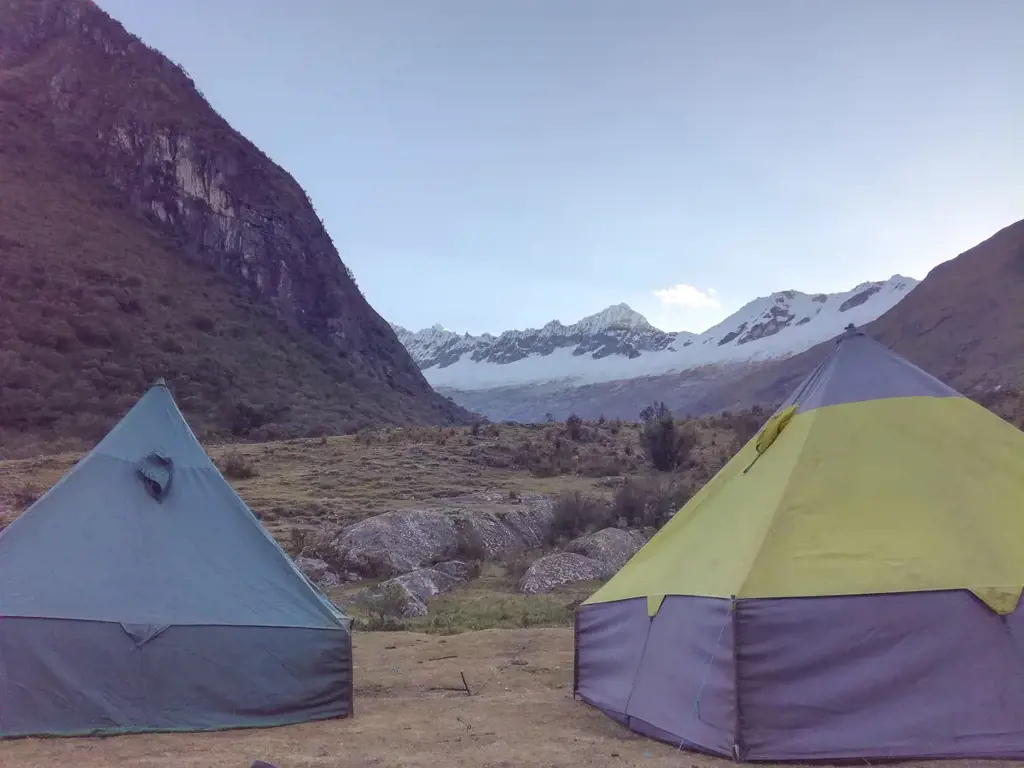
When planning a camping trip, one common question that often comes to mind is whether to bring your own camping equipment or if it's available for rent at the campsite. This decision can depend on a variety of factors, including the type of camping trip, the location, and personal preferences. In this article, we will explore the advantages and disadvantages of bringing your own camping equipment versus renting it.
Type of Camping Trip:
The type of camping trip you are planning can greatly influence your decision. If you are going on a short weekend trip and don't have a lot of camping gear, renting might be a convenient option. On the other hand, if you are an avid camper and frequently go camping, investing in your own camping gear can be cost-effective in the long run.
Location:
The location of your camping trip can also impact your decision. Some remote or less-populated areas may not have rental options available. In such cases, bringing your own equipment is the only option. Additionally, if you are planning to camp in a national park or a popular camping destination, it's best to check if rental services are available in advance.
Personal Preferences:
Some campers prefer the comfort and familiarity of their own camping equipment. If you are used to a particular type of tent, sleeping bag, or cooking gear, it may be more enjoyable to bring your own. Renting equipment can sometimes mean compromising on quality or not having access to the specific items you prefer.
Advantages of Bringing Your Own Camping Equipment:
- Familiarity and Comfort: Using your own camping gear ensures that you are comfortable and familiar with the equipment you will be using.
- Quality: By bringing your own equipment, you can ensure that you have high-quality gear that will last you for multiple trips.
- Cost: While there is an upfront cost to purchasing camping equipment, it can be more cost-effective in the long run, especially if you go camping frequently.
Advantages of Renting Camping Equipment:
- Convenience: Renting camping equipment can be more convenient, especially if you are traveling by plane or have limited storage space.
- Try Before You Buy: Renting allows you to try out different types of camping gear before making a purchase. This can help you make informed decisions about what to invest in for future trips.
- Reduced Maintenance: When you bring your own camping equipment, you are responsible for maintaining and storing it. Renting eliminates this responsibility and allows you to simply return the equipment after your trip.
In conclusion, the decision of whether to bring your own camping equipment or rent it ultimately depends on your individual circumstances and preferences. Consider factors such as the type of camping trip, location, and personal comfort when making your decision. Regardless of whether you decide to bring your own gear or rent it, the most important thing is to enjoy your camping adventure.
Essential Items to Pack for Red Cross Deployment
You may want to see also

What are some important items to include in a first aid kit for the Santa Cruz trek?
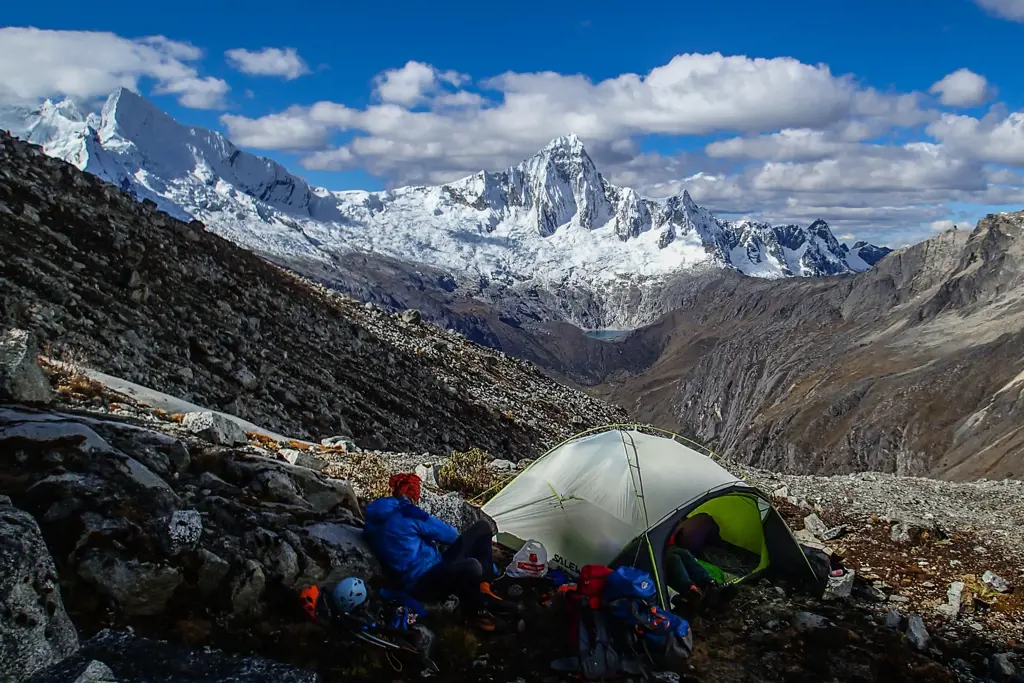
When embarking on the Santa Cruz trek in Peru, it is essential to be prepared with a well-stocked first aid kit. This challenging multi-day hike takes you through rugged and remote terrain, far from medical facilities. In the event of an injury or emergency, having the right supplies can make all the difference. Here are some important items to include in your first aid kit for the Santa Cruz trek:
- Adhesive bandages: These are essential for covering small cuts, blisters, or abrasions. Make sure to pack a variety of sizes to accommodate different wounds.
- Sterile gauze pads: These are useful for dressing larger wounds or creating pressure bandages. Opt for individually wrapped, sterile pads to prevent infection.
- Medical tape: Use this to secure bandages and dressings. Look for a hypoallergenic tape that won't irritate the skin.
- Antiseptic wipes: These are crucial for cleaning wounds and preventing infection. Alcohol-based wipes are a convenient option for sterilizing the skin.
- Antibiotic ointment: Apply this to wounds to prevent bacterial growth and aid in the healing process. Look for a broad-spectrum ointment that covers a range of bacterial species.
- Over-the-counter pain relievers: Ibuprofen or acetaminophen can help alleviate pain and reduce inflammation. These are particularly useful for minor sprains and muscle aches.
- Oral rehydration salts: This is vital for replenishing electrolytes and preventing dehydration. In the event of diarrhea or intense physical exertion, these salts can help restore the body's balance.
- Tweezers: These are useful for removing splinters or small foreign objects from the skin. Make sure they have a pointed tip and are made of stainless steel for durability.
- Digital thermometer: This is essential for monitoring body temperature, especially in the event of fever or heat-related illnesses. Make sure it is a reliable and accurate model.
- Moleskin or blister pads: Prevent blisters or provide relief for existing blisters with these handy pads. Cut them to size and apply them to areas prone to friction.
- Safety pins: These can be used for securing bandages or clothing, or for improvising splints in emergency situations.
- Emergency blanket: These lightweight, heat-reflective blankets are essential for staying warm in case of extreme cold or shock. They are compact and can be easily stored in a first aid kit.
- Disposable gloves: Protect yourself and others from contamination by wearing disposable gloves when providing first aid. Opt for non-latex gloves if you or someone in your group has a latex allergy.
- Scissors: These will come in handy for cutting tape, clothing, or bandages. Choose a pair with rounded edges to minimize the risk of injury.
- First aid manual: It's important to have a comprehensive guide on hand that outlines basic first aid techniques and provides instructions for emergency situations. Familiarize yourself with its contents before embarking on the trek.
Remember, it's not enough to simply have these items in your first aid kit. Make sure you know how to use each one and have a basic understanding of first aid principles. Additionally, consider taking a first aid and CPR training course before setting off on the Santa Cruz trek. Being prepared and knowledgeable can help ensure your safety and the safety of those around you.
Essential Packing Guide for Your First Trip with Your Girlfriend
You may want to see also

Are there any special considerations for packing food and water for the trek?
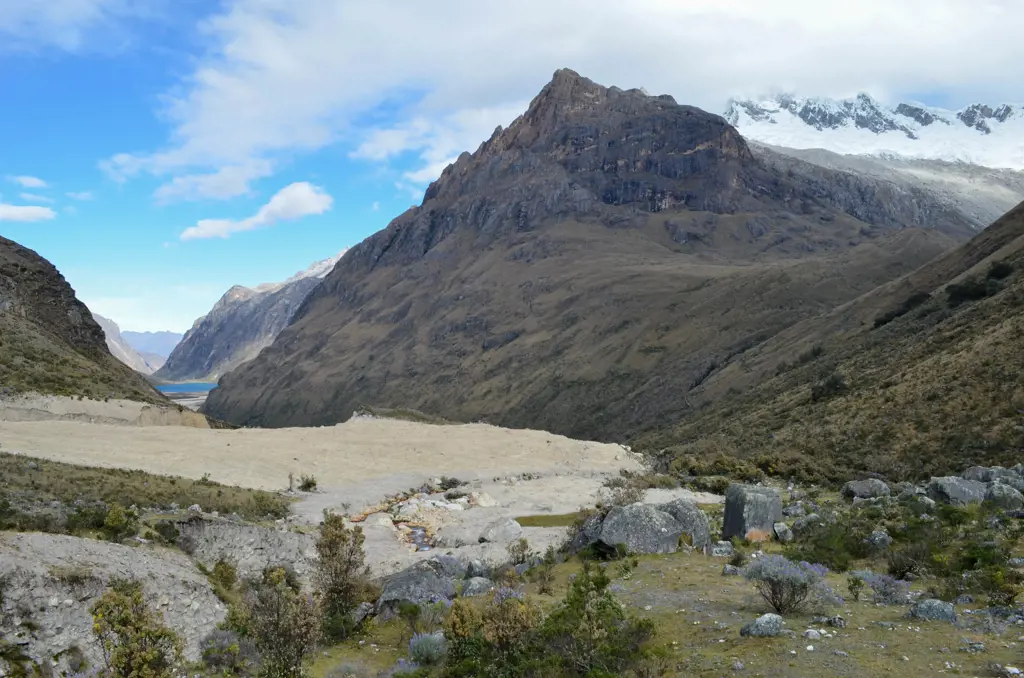
When planning for a trek, it is important to give careful thought to packing your food and water. The right choices can make a significant difference in your energy levels and overall enjoyment of the trip. In this article, we will discuss some special considerations for packing food and water for a trek, based on scientific research and personal experience.
- Calculate your caloric needs: The first step in packing food for a trek is to determine how many calories you will need each day. This can vary depending on factors such as your weight, age, sex, and the difficulty of the trek. A general rule of thumb is to aim for 2,500-3,000 calories per day, but it's best to consult with a nutritionist or trekking expert to get a more accurate estimate.
- Choose lightweight and nutrient-dense foods: Since you'll be carrying everything on your back, it's important to choose foods that are lightweight but still provide the necessary nutrients. Opt for dehydrated or freeze-dried meals, as they are lightweight and easy to prepare. Include a mix of carbohydrates (such as oats, rice, or pasta), proteins (such as nuts, seeds, or jerky), and healthy fats (such as olive oil or nut butter) to keep your energy levels up.
- Pack easy-to-eat snacks: Snacks are essential for keeping your energy levels steady throughout the trek. Choose snacks that are easy to eat on the go and don't require much preparation. Some examples include energy bars, trail mix, dried fruits, and beef jerky. These snacks provide a quick source of energy and are also lightweight and compact.
- Prioritize water purification: Hydration is crucial during a trek, but carrying enough water can be impractical due to its weight. Instead, bring a lightweight water filter or purification tablets to ensure a constant supply of safe drinking water. This way, you can refill your water bottle from streams or lakes along the trekking route, minimizing the weight you have to carry.
- Consider electrolyte replacement: Sweating during a trek can lead to electrolyte imbalances, which can affect your performance and overall well-being. It's a good idea to bring along electrolyte supplements or sports drinks to replenish these vital minerals. Look for options that are portable and easy to mix with water.
- Pack extra supplies: It's always a good idea to pack extra food and water in case the trek takes longer than anticipated or unexpected circumstances arise. Aim to have at least one extra day's worth of supplies in case of emergencies.
In conclusion, packing food and water for a trek requires careful consideration of caloric needs, nutrient density, and weight. By following the steps outlined above and making smart choices, you can ensure that you have adequate nourishment and hydration throughout your trek. Remember to consult with experts or experienced trekkers for personalized advice and recommendations.
Essential Items to Pack for Your Journey to Katahdin
You may want to see also
Frequently asked questions
It is important to pack clothing suitable for both warm and cold weather. In the daytime, temperatures can reach up to 70°F (21°C), so bring lightweight, breathable clothing such as t-shirts, shorts, and a hat. However, at night temperatures can drop as low as 14°F (-10°C), so pack warm layers like a fleece or down jacket, long pants, and thermal underwear. It is also advisable to bring a waterproof jacket or poncho in case of rain.
It is recommended to bring sturdy and comfortable hiking boots that provide good ankle support. The trek involves walking on uneven terrain and crossing streams, so it is important to have footwear that can handle these conditions. Make sure your boots are broken in before the trek to avoid blisters. It is also a good idea to pack a pair of lightweight, breathable hiking sandals for wearing around camp or for crossing shallow water.
In addition to clothing and footwear, there are a few other essential items you should bring. It is important to have a good quality backpack that can comfortably carry all your gear. A sleeping bag rated for cold weather is necessary as temperatures can drop significantly at night. Other essentials include a headlamp, sunscreen, insect repellent, a water bottle or hydration system, a first aid kit, and a camera to capture the stunning scenery along the trek. Don't forget to pack snacks and extra food as well, as there are limited opportunities to stock up along the trail.







